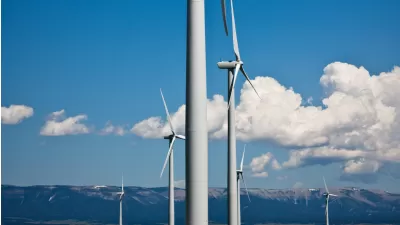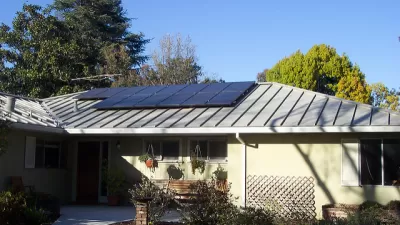A committee passed a bill written to meet Gov. Jerry Brown's 2030 environmental goals: Reduce oil consumption by 50 percent, require renewables to supply 50 percent of electricity generation, and double energy efficiency in existing buildings.
SB 350, the Clean Energy and Pollution Reduction Act of 2015 and dubbed 50-50-50, was introduced by Senate President Pro Tem Kevin de León (D-Los Angeles) and Senator Mark Leno (D-San Francisco). It passed the Senate Standing Committee on Energy, Utilities and Communications on April 7, writes Katie Orr of Capital Public Radio in Sacramento. She adds that opposition from the usual suspects has already surfaced.
The California Chamber of Commerce calls the bill a job killer [listed under "Increased Fuel Costs"]. The Western States Petroleum Association (WSPA) says it would give too much power to the state’s air resources board.
The goals will supplement legislation (SB 32) by Sen. Fran Pavley (D-Agoura Hills) to extend the state's carbon emission targets past 2020. SB 350 will enable the three goals Gov. Jerry Brown listed in his January inaugural address.
- The amount of renewables in electricity generation, referred to as the Renewable Portfolio Standard, increases from 33 percent by 2020 to 50 percent by 2030.
- Cutting petroleum use in half in 15 years will be a difficult goal to meet. The Senate's California Climate Leadership webpage on SB 350 points to a pathway: "In a [California Air Resources Board] CARB analysis, one pathway towards this goal could include reducing growth in vehicle-miles traveled to 4%; increasing on-road fuel efficiency of cars to 35 mpg and heavy-duty trucks to 7 mpg; and at least doubling the use of alternative fuels such as biofuels, electricity, hydrogen, and renewable natural gas. One pathway to achieve this goal can be found on the CARB Website [one-page PDF]."
- SB 350 supplements existing legislation that requires "energy efficiency standards for new buildings and appliances", notes California Climate Leadership. "One pathway to achieve a 50% greater efficiency in buildings can be found here [PDF].
It will be interesting how this bill evolves through the legislative process. With both WSPA and the Chamber targeting the second goal above, and with data indicating that Californians increased oil consumption last year, breaking a seven-year trend, I can't help but wonder if the oil reduction will withstand their onslaught, at least with the current target of a 50 percent reduction by 2030.
Next stop: Senate Environmental Quality Committee later this month.
FULL STORY: California Considers Stricter Carbon Standards

Trump Administration Could Effectively End Housing Voucher Program
Federal officials are eyeing major cuts to the Section 8 program that helps millions of low-income households pay rent.

Planetizen Federal Action Tracker
A weekly monitor of how Trump’s orders and actions are impacting planners and planning in America.

Canada vs. Kamala: Whose Liberal Housing Platform Comes Out on Top?
As Canada votes for a new Prime Minister, what can America learn from the leading liberal candidate of its neighbor to the north?

Washington State’s Parking Reform Law Could Unlock ‘Countless’ Acres for New Housing
A law that limits how much parking cities can require for residential amd commercial developments could lead to a construction boom.

Wildlife Rebounds After the Eaton Fire
Following the devastation of the Eaton Fire, the return of wildlife and the regrowth of native plants are offering powerful signs of resilience and renewal.

LA to Replace Inglewood Light Rail Project With Bus Shuttles
LA Metro says the change is in response to community engagement and that the new design will be ready before the 2028 Olympic Games.
Urban Design for Planners 1: Software Tools
This six-course series explores essential urban design concepts using open source software and equips planners with the tools they need to participate fully in the urban design process.
Planning for Universal Design
Learn the tools for implementing Universal Design in planning regulations.
Central Transportation Planning Staff/Boston Region MPO
Heyer Gruel & Associates PA
Institute for Housing and Urban Development Studies (IHS)
City of Grandview
Harvard GSD Executive Education
Regional Transportation Commission of Southern Nevada
Toledo-Lucas County Plan Commissions




























